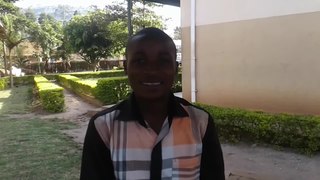Related Research Articles

The Luhya are a bantu people and the second largest ethnic group in Kenya. The luhya are native to western Kenya and Uganda. They are divided into 20 culturally and linguistically united clans. Tracing the origins and history of Abaluhya identity, they migrated to present Uganda and Kenya just like other Bantu people who migrated to different parts of Africa from a place in their traditional oral history passed on by their forefathers to the next generations which is referred to as Misri or Egypt
Matuumbi, also known as Kimatuumbi and Kimatumbi, is a language spoken in Tanzania in the Kipatimu region of the Kilwa District, south of the Rufiji river. It is a Bantu language, P13 in Guthrie's classification. Kimatuumbi is closely related to the Ngindo, Rufiji and Ndengereko languages. It is spoken by about 70,000 people, according to the Ethnologue.
Bukusu is a dialect of the Masaba language spoken by the Bukusu tribe of the Luhya people of western Kenya. It is one of several ethnically Luhya dialects; however, it is more closely related to the Gisu dialect of Masaaba in eastern Uganda than it is to other languages spoken by the Luhya.
Luhya is a Bantu language of western Kenya.
The Gisu people, or Bamasaba people of Elgon, are a Bantu tribe of the Masaba people of eastern Uganda, closely related to the Bukusu people of Kenya. Bamasaba live mainly in the Mbale District of Uganda on the slopes of Mount Elgon. The Bagisu are estimated to number 1,646,904 people and to make up 4.9% of the total population according to the 2014 National Census of Uganda. European missionaries introduced the Gisu people to Christianity in the late 1890s, and established an Anglican system of governance in the traditional areas where they lived. Around 14 percent of the Bagisu people follow Islam according to the 2002 Census estimate.
Kamba, or Kikamba, is a Bantu language spoken by millions of Kamba people, primarily in Kenya, as well as thousands of people in Uganda, Tanzania, and elsewhere. In Kenya, Kamba is generally spoken in four counties: Machakos, Kitui, Makueni, and Kwale. The Machakos dialect is considered the standard variety and has been used in translation. The other major dialect is Kitui.

Kenya is a multilingual country. The two official languages of Kenya, Swahili and English are widely spoken as lingua francas; however, including second-language speakers, Swahili is more widely spoken than English. Swahili is a Bantu language native to East Africa and English is inherited from British colonial rule.

Kiga is a Great Lakes Bantu language of the Kiga people (Bakiga). Kiga is a similar and partially mutually intelligible with the Nkore language. It was first written in the second half of the 19th century. Kiga is largely spoken in the ancient Kigezi region which includes about 5 districts, namely Rubanda, Rukiga, Kabale, Kanungu and some parts of Rukungiri. As of 2021, Kiga is spoken natively by about 1.3 million people in Uganda.
The Great Lakes Bantu languages, also known as Lacustrine Bantu and Bantu zone J, are a group of Bantu languages of East Africa. They were recognized as a group by the Tervuren team, who posited them as an additional zone to Guthrie's largely geographic classification of Bantu.
Nyole is a Bantu language spoken by the Luhya people in Vihiga District, Kenya. There is 61% lexical similarity with a related but different Nyole dialect in Uganda.
The Zigula or Zigua language, Chizigua, is a Bantu language of Tanzania and Somalia, where the Mushunguli dialect is spoken.
Mijikenda is a Bantu dialect cluster spoken along the coast of East Africa, mostly in Kenya, where there are 1.9 million speakers but also in Tanzania, where there are 100,000 speakers. The name Mijikenda means "the nine settlements" or "the nine communities" and refers to the multiple language communities that make up the group. An older, derogatory term for the group is Nyika which refers to the "dry and bushy country" along the coast.
Eton, or Ìtón, is a Bantu language spoken by the Eton people of Cameroon.
Kuria is a Bantu language spoken by the Kuria people of Northern Tanzania, with some speakers also residing in Kenya.
Samia (Saamia) is a Bantu language spoken by the Luhya people of Uganda and Kenya. Ethnologue includes Songa as a dialect, but it may be a separate language.
Idakho, Isukha, and Tiriki are mutually intelligible Kenyan languages within the Luhya ethnic group. They are a set of languages closely related to some other Luhya ethnic groups like Maragoli, but less so in comparison to others, like Bukusu,Tachoni or Samia,
Logooli is a Bantu language with several hundred thousand speakers in Kenya and a few hundred speakers in Mara Region, Tanzania. It is spoken by the Maragoli, the second-largest Luhya tribe, but is not particularly close to other languages spoken by the Luhya.
Ruuli is the Bantu language spoken by the Baruuli and Banyala people of Uganda primarily in Nakasongola and Kayunga districts. It is closely related to Ganda and Gwere.
Marachi is a Bantu language spoken by the Luhya people of Kenya.
Khayo (Xaayo) is a Bantu language spoken by the Luhya people of Kenya.
References
- ↑ Masaba (Gisu, Kisu, Dadiri, Buya) at Ethnologue (18th ed., 2015) (subscription required)
Bukusu (Tachoni) at Ethnologue (18th ed., 2015) (subscription required)
Tachoni at Ethnologue (18th ed., 2015) (subscription required) - ↑ Jouni Filip Maho, 2009. New Updated Guthrie List Online
- ↑ Maho (2009)